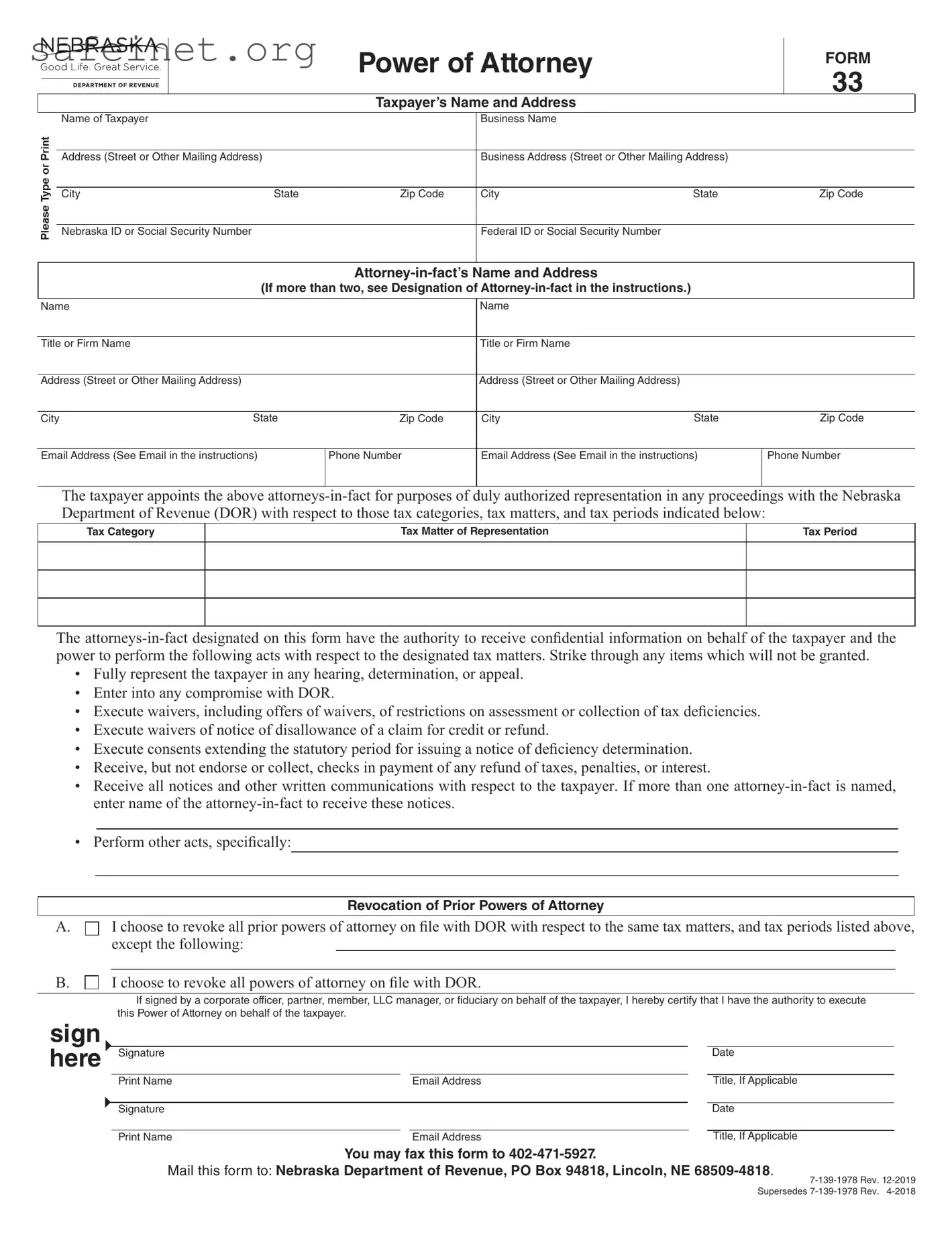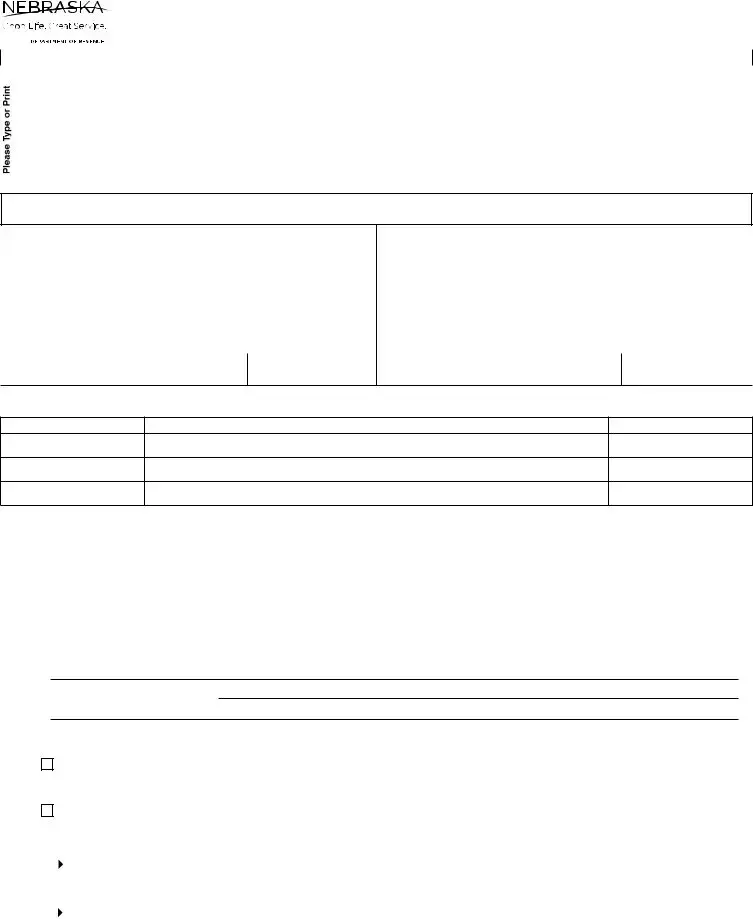Who Must File. Any taxpayer who wishes to secure representation by another party in matters before the Nebraska Department of Revenue (DOR) with regard to any tax imposed by the tax laws of the State of Nebraska, must fle a Power of Attorney (POA), Form 33, or other appropriate POA. A POA authorizes that party to receive confdential tax information regarding the taxpayer. The Form 33 is provided for the taxpayer’s convenience in designating a POA, but it is not the sole form which may be used. DOR will honor all other properly completed and signed POA authorizations.
When and Where to File. The completed Form 33 may be fled any time. This form, or another properly completed and signed POA, must be fled with DOR before any person designated can represent the taxpayer in matters involving disclosure of confdential tax information.
This form, or other appropriate POA, may be faxed or mailed to DOR:
•Fax to 402-471-5927; or
•Mail to the Nebraska Department of Revenue, PO Box 94818, Lincoln, NE 68509-4818.
Taxpayer’s Name and Address. If the taxpayer is an individual, a Social Security number must be listed. If a married, fling jointly return was fled, enter both spouses’ Social Security numbers in the spaces provided.
If the taxpayer is a corporation, partnership, or association, enter the name, state and federal ID numbers (if applicable), and the business address. If the Form 33 will be used in a tax matter in the case of a partnership for which the names, addresses, and Social Security numbers or ID numbers have not already been furnished to DOR, these items should be listed on an attached sheet.
If the taxpayer is an estate or trust, enter the name, title, and address of the fduciary, as well as the name and ID number or Social Security number of the taxpayer. If this space is used to list other information, clearly label the change.
Designation of Attorney-in-fact. An attorney-in-fact is any person who is acting on behalf of another. Enter the appropriate information pertaining to each person to whom representative authority and power is being delegated. Space is provided for listing two appointees. If additional space is required, attach a separate sheet clearly showing the names, addresses, zip codes, and phone numbers of the additional appointees. The mailing address, email address, and phone number listed on this form are permissible means of communicating with the taxpayer.
Email. By entering an email address, the taxpayer acknowledges that DOR may contact the taxpayer by email. The taxpayer accepts any risk to confdentiality associated with this method of communication. DOR will send all confdential information by secure email or the State of Nebraska’s fle share system. If you do not wish to be contacted by email, write “Opt Out” on the line labeled “email address.”
Tax Category, Tax Matter, and Tax Period. Form 33 is designed to clearly express the scope of the authority granted by the taxpayer to any attorneys-in-fact. In the space provided, designate all tax categories, tax matters, and tax periods for which this Form 33 is being fled. The authorization granted must be clearly identifed.
“Tax Category” requires a list of the type of tax, such as “income” or “sales and use.” “Tax Matter of Representation” requires a brief summary of the subjects for which the attorney- in-fact will represent the taxpayer. These may include, but are not limited to: tax assessment resulting from an audit; abatement of penalty; claim for refund; or formal hearing. “Tax Period” requires a designation of a specifc year or time period. Reference can be made to “all years” or “all periods.” As many as three entries may be listed on one form.
Authorized Acts. The Form 33 lists several acts which can be performed by the attorney-in-fact. This list is intended to cover the most commonly appointed acts. If the taxpayer does not wish to authorize the named attorney-in-fact regarding a particular act which is listed, the taxpayer must strike through any power which is not granted. This is particularly important with respect to correspondence from DOR to the taxpayer regarding the designated tax matters. If the taxpayer wants to receive refund claim approvals or denials, and other notices and written communications, rather than have the attorney-in-fact be the recipient, strike through that authorization. Otherwise, DOR will send notices and other written communications to the designated attorney-in-fact. Notices of defciency determination and amended notices will always be mailed to the taxpayer directly even if a POA exists for the taxpayer. A copy will be furnished to the designated attorney-in-fact.
If the taxpayer wishes to authorize an act which is not listed, a concise and specifc statement about the additional authorization must be made in the space provided, or a separate signed statement may be attached to the Form 33.
Revocation of Prior Powers of Attorney. To revoke any POAs previously fled with DOR, choose Box A or B.
Box A. Checking this box allows the taxpayer the option of revoking all POAs on fle with DOR with the exception of those listed on the lines provided (or on a list attached to the Form 33). Check box A and list the names, addresses, and zip codes of the attorneys-in-fact whose representative authority is not revoked. The date of the earlier POA must also be listed. Copies of the earlier POAs which are to remain in effect may be included instead of the list. Be sure to sign the form.
Box B. Checking this box revokes all POAs previously fled with DOR. Check Box B, and sign the form.
If no boxes are checked, all prior POAs will remain in force.
Signature. The taxpayer must sign and date the form. If spouses fle a married, fling jointly income tax return, which both have signed, then both spouses must sign the Form 33. If only one spouse in a married couple signs Form 33, then a separate Form 33 must be signed by the other spouse. If there is only one spousal signature or a second POA is not signed, then only the person designated by the POA would be authorized to perform the acts authorized by the POA. The nonsigning spouse who has fled a joint return with his or her spouse may still obtain information about, and may discuss issues regarding, the couple’s joint return. However, a person may not authorize another party, or themselves, to receive confdential tax information regarding separate returns fled by the person’s spouse.
Only certain people may represent a taxpayer in a contested case once a hearing offcer is appointed: (1) the taxpayer;
(2)a Nebraska attorney; or (3) a non-Nebraska attorney in good standing who partners with a Nebraska lawyer in representation.
If the taxpayer is a partnership, all partners must sign, unless one is duly authorized to act in the name of the partnership. Nebraska has adopted the Uniform Partnership Act of 1998 (Neb. Rev. Stat. §§ 67-401 to 67-467) making each partner a business agent duly authorized to act for any partnership formed in Nebraska. Authorized signatures for nonresident partnerships will be governed by the laws of the state in which the partnership was formed.
If the taxpayer is a corporation or an association, an offcer having authority to bind the entity must sign. The offcer must indicate his or her offcial title on the line provided.
If the taxpayer is a Nebraska limited liability company (LLC), then the Form 33 must be signed by a member of the LLC. The validity of the authorizations made by a foreign LLC will be determined governed by the laws of the state in which the LLC was organized.

